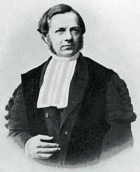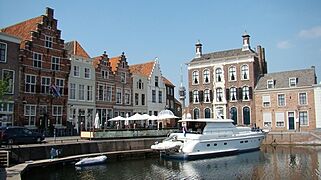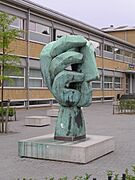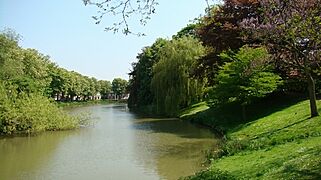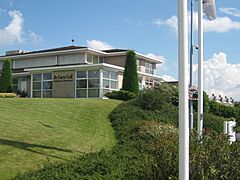Goes facts for kids
Quick facts for kids
Goes
|
|||
|---|---|---|---|
|
City and municipality
|
|||

Harbour of Goes
|
|||
|
|||

Location in Zeeland
|
|||
| Country | Netherlands | ||
| Province | Zeeland | ||
| Government | |||
| • Body | Municipal council | ||
| Area | |||
| • Total | 101.92 km2 (39.35 sq mi) | ||
| • Land | 92.68 km2 (35.78 sq mi) | ||
| • Water | 9.24 km2 (3.57 sq mi) | ||
| Elevation | −1 m (−3.3 ft) | ||
| Population
(May 2014)
|
|||
| • Total | 37,050 | ||
| • Density | 400/km2 (1,000/sq mi) | ||
| Demonym(s) | Goesenaar | ||
| Time zone | UTC+1 (CET) | ||
| • Summer (DST) | UTC+2 (CEST) | ||
| Postcode |
4460–4483
|
||
| Area code | 0113 | ||
Goes (Dutch pronunciation: [ɣus]) is a city and municipality in the southwestern Netherlands. It is located on Zuid-Beveland, in the province of Zeeland. About 29,000 people live in the city of Goes.
Contents
Discovering the History of Goes
How Goes Began
Goes started in the 10th century next to a small river called de Korte Gos. The village grew quickly. By the early 12th century, it had a market square. It also had a church named after Mary Magdalene. Around the year 1300, a brick castle was built. Today, this castle is known as Oostende Castle.
Becoming a City
In 1405, Goes officially became a city. This right was given by William II, Duke of Bavaria. He was the count of Holland at that time. In 1417, the city was allowed to build strong walls for protection. Goes became rich from making cloth and producing salt.
Challenges and Changes
In the 16th century, Goes faced some problems. The connection to the sea became blocked by mud. This made it harder for ships to reach the city. In 1554, a big fire destroyed part of Goes.
During the Eighty Years' War in 1572, Dutch and English soldiers tried to take Goes. Spanish soldiers, called tercios, saved the city. They walked through the Scheldt river to surprise the attackers. In 1577, Maurice of Nassau, a Dutch prince, drove out the Spanish soldiers. He built a defense wall around Goes, and parts of it are still there today.
From the 1600s, Goes was mainly an agricultural center. This means farming was its main activity. A railway was built in 1868, but it did not bring many factories. Farming is still very important for the economy of Goes.
Goes in Modern Times
The Netherlands stayed neutral during the First World War. However, seven bombs hit Goes and Kloetinge by mistake from a British airplane. One house was destroyed, and one person died. Goes was occupied by German forces until 1944 during the Second World War. Luckily, it did not suffer much damage.
Goes started to grow a lot in the 1970s and 1980s. Many new neighborhoods were built, like Goese Meer and Oostmolenpark. Today, Goes is the fourth largest economic center in Zeeland. More new neighborhoods are being planned, such as Goese Schans and Aria. These will add about 3,000 new homes.
Exploring Goes: Population Centers and Districts
Population Centers in Goes
The municipality of Goes includes several smaller towns and villages. These are:
- Eindewege
- Goes (the main city)
- 's-Heer Arendskerke
- 's-Heer Hendrikskinderen
- Kattendijke
- Kloetinge
- Oud-Sabbinge
- Wilhelminadorp
- Wolphaartsdijk
Topography of Goes
Main Districts of Goes
Goes is divided into many different areas or districts. These include:
- Centre Goes
- West Goes
- New West
- East Goes
- Noordhoek
- Goese Meer
- Goese Polder
- South Goes
- Overzuid
- Ouverture
- De Goese Poort (a business area)
- De Poel (business areas I, II, III, and IV)
- Klein Frankrijk (a business area)
- Marconi (a business area)
- Aria (currently being developed)
- Mannee
- Goese Schans (currently being developed)
Goes and the World: International Connections
Twin Towns and Sister Cities
Goes used to be a twin town with Panevėžys in Lithuania. This means they had a special friendship agreement. However, the town council decided to end this twinning on July 22, 2021.
Getting Around: Transport in Goes
Goes has its own railway station. It is part of the Roosendaal–Vlissingen railway line. This makes it easy to travel to and from Goes by train.
Famous People from Goes
Many interesting people have come from Goes.
Thinkers and Public Servants
- Cornelis van Watervliet (1592–1636), who was a Mayor of Goes. He was also part of the Court of Audit of Zeeland. He is buried in De Maria Magdalenakerk.
- Cornelis Caesar (around 1610–1657), a merchant and governor of Formosa.
- C. H. D. Buys Ballot (1817–1890), a chemist and weather expert. He created Buys Ballot's law, which helps predict wind direction.
- Isaäc Dignus Fransen van de Putte (1822–1902), a politician.
- Jacob Adriaan de Wilde (1879–1956), a politician and lawyer.
- Pieter Jacobus Wemelsfelder (1907–1995), an engineer who worked with water.
- Leendert Ginjaar (1928–2003), a politician and chemist.
- Bas van Fraassen (born 1941), a philosopher.
- Albert J. R. Heck (born 1964), a scientist and professor.
- Katinka Simonse (born 1979), known as Tinkebell, an artist.
Artists and Performers
- Willem Eversdijck (around 1620–1671), a painter from the Dutch Golden Age.
- Pieter Peutemans (1641–1698), another painter from the Dutch Golden Age.
- Pieter Adriaan Jacobus Moojen (1879- 1955), an architect, painter, and writer.
- Leo van Doeselaar (born 1954), a classical organist and conductor.
- Boudewijn Vincent Bonebakker (born 1968) and Frank Harthoorn, guitarists for the band Gorefest.
Sports Stars
- Myrna Veenstra (born 1975), a former field hockey player. She won a bronze medal at the 2000 Summer Olympics.
- Martijn Dieleman (born 1979), a former Dutch volleyball player. He competed at the 2000 Summer Olympics.
- Lesley Pattinama Kerkhove (born 1991), a tennis player.
- Consus, the winner of the 2023 GeoGuessr World Cup.
Gallery
See also
 In Spanish: Goes (Países Bajos) para niños
In Spanish: Goes (Países Bajos) para niños











